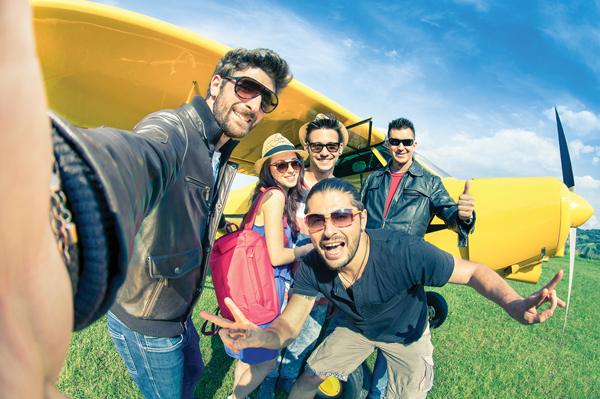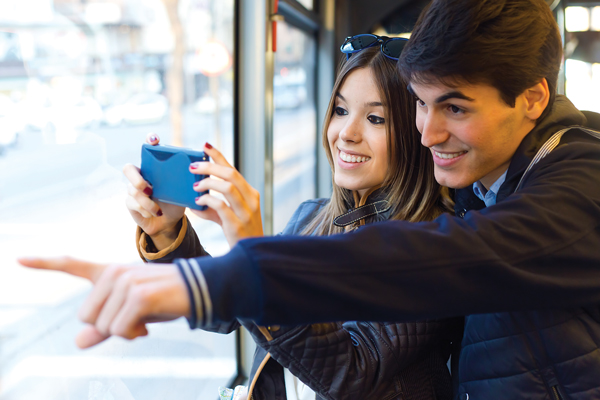BY PAT CHARLA
 As chauffeured transportation evolves, the response from premium operators to those rapidly changing traveler expectations may be what determines a company’s continued success—and, beyond that, its very survival. You’ll need to consider things like how you plan on generating new revenue streams in a changing economy and how your very business model will have to adapt to the demands of the future. Even more importantly, you’ll need to alleviate the tremendously negative pressure on your rates, your profit, and your bottom line that will likely escalate as even affiliate trips shift with significant industry consolidation in the corporate market. But how?
As chauffeured transportation evolves, the response from premium operators to those rapidly changing traveler expectations may be what determines a company’s continued success—and, beyond that, its very survival. You’ll need to consider things like how you plan on generating new revenue streams in a changing economy and how your very business model will have to adapt to the demands of the future. Even more importantly, you’ll need to alleviate the tremendously negative pressure on your rates, your profit, and your bottom line that will likely escalate as even affiliate trips shift with significant industry consolidation in the corporate market. But how?
What your customers want has already changed in a trend that gained steam especially with Millennial corporate travelers: “The future is not in cookie-cutter tours, packaged, highly commercialized one-price-fits-all air/hotel/tour programs or even those brave souls departing on self-directed ‘we’ll see what develops’ traveler plans either. Consumer attitudes are changing, and people want to travel better, on a deeper emotional and more personal level,” according to The Rise of Experiential Travel report by Skift + Peak.
Social media and digital innovation has driven much of this change. From a pure marketing perspective, social media has inspired wanderlust and the desire to travel. This has been coined as the “Instagram Effect” and has resulted in greater awareness of the travel “experience,” which allows people to view the world through the lenses of untold others. Many corporate travelers in the past could say that they were well traveled because they had been to many cities, but that would often be limited to flying in and out, without ever getting a chance to explore. With experiential travel, it means the difference between traveling just to make the company money (abhorent in younger generations) and building a satisfying, memorable experience while on a successful business trip—and possibly doing some good in the process.
Visual marketing is no longer a typically cheesy group photo in front of the Eiffel Tower; now, world travelers want to show off the meals they enjoyed and even helped prepare at the obscure Parisian bistro only locals know about. Seeing the world is less about checking off a travel bucket list these days and more about digging into the nuances of another culture to truly experience the globe’s farthest foreign reaches.
 What Does This Mean?
What Does This Mean?
Globalization and technology are influencing people in such a way that many are rejecting the ordinary trip of the past decade and are now craving more “authentic” experiences that reveal the complexities of a destination’s unique culture and personality. This isn’t just limited to tour business: Corporate travelers, especially Millennials, will tack on an additional day or two to enjoy the area. No longer is superficial visitation of landmarks sufficient to placate the customer, but it is imperative to delve deeper into a destination’s inner mechanisms and experience culture on an intimate and life-changing level. Of course, this doesn’t mean that the Eiffel Tower, the Empire State Building, and the Golden Gate Bridge should be dropped from a traveler’s itinerary, as people will still want to see iconic sites. Experiential travel means having it all: Seeing wonderful and hyperlocal attractions but also watching real people living real lives. They want to become part of the fabric of the city, if even for a few days.
Is this just a trend? Certainly not according to many executives whose companies depend on upscale travel and consumer markets. They are struggling to find ways to maintain marketshare as buyer expectations and demographics change. For example, when Hyatt’s CEO discussed plans earlier this year for attracting and keeping their perfect client—the high-end, luxury guest—Mark Hoplamazian says that a primary focus “is ensuring that we’re delivering experiences, not just a place to stay, in all of our interactions with our guests.”
This list goes on and on. As a matter of fact, according to many industry observers, one thing is clear when we talk about luxury travel in 2017 and beyond: Luxury is now focused less on flaunting brand names or possessing the latest shiny things and more on emotional content and experiences for travelers. You are one of the best sources of experiential travel: You already excel at blending local culture and luxury travel because you have the connections and an understanding of service to do it right.
“Consumer attitudes are changing, and people want to travel better, on a deeper emotional and more personal level.”
Capitalizing on the Shift
To understand the differences between “traditional” and experiential travel, consider the popularity of wine tours, which practically any operator can do successfully. Traditional tours usually include booking a group for a minicoach or bus, visiting a handful of wineries, and hoping that no one gets sick on the way back. There’s nothing wrong with that.
Now, let’s look at the luxury experiential version. Whether you were creating an experience for two people, 10 people, or 50 people, your private and exclusive “adventure” started with the guests being welcomed by their chauffeur, who introduces the local sommalier accompanying your guests in a BMW 7-Series sedan, a Mercedes-Benz Sprinter, or a Grech minicoach (i.e., premium and not just luxury). On the way, the sommalier entertains passengers with conversation about the history of the vineyards they are visiting, the grapes, the process, the differences, and generally provides expert commentary about the experience they are about to enjoy. At the first stop, you have prearranged for an expert employee to do a behind-the-scenes tour of the vines and barrels and everything that goes on in the production of their wine. Of course, there is a private tasting room where your sommalier conducts the tasting with the assistance of the vineyard servers, which includes vintages not offered to the general public. Depending on distance, you rinse and repeat with several other wineries. The group’s final stop is for a private dinner at a hot eatery that only locals know, where the chef explains why he has selected the regionally sourced ingredients he is using for his multi-course, socially conscious meal.
Now, would you call that a wine tour? I’d call it an experience, and one that, no matter how few or many people were involved, would cost thousands of dollars. Are there buyers? Absolutely: The trip I just described was an “experience” a friend of mine simply can’t stop raving about.
 It is important that you work to develop the relationships with your area partners and ensure that you have formal contracts with each so that the actual experiences are repeatable and always available for sale (except seasonal offerings). This is not a market that you can sell by throwing up a Facebook ad or sending a single email, and you certainly can’t do it “on the cheap.” Experiential travel marketing is sophisticated, and you need a plan, a system, consistency, and an understanding of who you are dealing with and what they want. This is true B2B marketing because you are going to be working with, and through, partners.
It is important that you work to develop the relationships with your area partners and ensure that you have formal contracts with each so that the actual experiences are repeatable and always available for sale (except seasonal offerings). This is not a market that you can sell by throwing up a Facebook ad or sending a single email, and you certainly can’t do it “on the cheap.” Experiential travel marketing is sophisticated, and you need a plan, a system, consistency, and an understanding of who you are dealing with and what they want. This is true B2B marketing because you are going to be working with, and through, partners.
One of your first steps should be to search out luxury and experiential travel agencies. Many are the small, privately owned survivors of the 1990-2000 disruption of the travel industry, but all have very strong relationships with their clients and are particular about who they do business with. If you have a reputation for high-caliber service, why wouldn’t they use you to provide the authentic experience?
Your “adventurers” do not want to be left to their own devices or be put at risk in cities that they are not familiar with—and heaven help us if they aren’t always digitally connected. But this is your advantage: Operators, especially smaller ones, provide a balance between a personalized and independent experience, and depend on the support and assistance of professional service providers and subject matter experts.
DMCs and convention and visitors’ bureaus are quite literally local experts who can also connect you with travelers. Even if you don’t have the ability to do large-group work, these organizations will add you to a list of preferred companies or refer you to clients—especially if you develop an amazing and unique offering.
Another important partner is the hospitality industry as hotels are desperate to develop experiential experiences for their guests. As their guests are no longer driven to all-inclusive resorts, happy to dine exclusively at the hotel’s restaurants, or participate in hotel-provided large- group tours, the opportunity to work with local hotels is huge. Many operators already have those relationships. Leverage those contracts to provide a solution to the problem that hotels, especially boutique properties, are longing for. Remember, they are competing with the sharing economy, too.
“With experiential travel, it means the difference between traveling just to make the company money (abhorent in younger generations) and building a satisfying and memorable experience while on a successful business trip.”
Finding Your Ideas
I had an operator say to me not long ago that “we don’t have anything here,” referring to the opportunity to establish experiences in his local market. After some suggestions, we discovered that he did, indeed, have opportunities—every city does. It is important to remember that the market you operate in is, just as any other human settlement, a living and breathing entity. You don’t need to be New York, Los Angeles, or Miami to take advantage of this niche. There are plenty of uniquely local places to share with customers, so don’t be afraid to try something that seems off the beaten path because that’s what makes it charming. After all, going beyond the typical package tour is what this is all about, so you can ask the customer how you can personalize the experience. It can also be a seasonal or limited-time attraction, as long as you heavily and properly market it beforehand to capture that business.
What’s next: Some experts say that “transformation travel” is the next step in this trend, which includes an element of self-development or social change. This is especially popular for those traveling abroad who want to gain that non-Western perspective and who want their business travel to give back as much as they are expected to put into it. But honestly, it’s often mostly about the likes on social media that such pics will generate—so it has to be one of a kind.
Don’t Underestimate Reputation and Word-of-Mouth Marketing
The closer to the local culture you and your company can bring a traveler, the better the chance your partner or the travelers themselves become repeat buyers or suggest you to another client. This is one of the reasons why not investing in this market might just result in your not thriving in a changing landscape. Just as you always suggest transportation in the destination city for your airport passengers, you can suggest this as an add-on for all kinds of travelers, even those who might enjoy playing tourist in their own town.
Digital innovation is steering potential travelers from traditional travel websites and moving them more and more toward review sites. In the case of experiential travel, TripAdvisor is an excellent place to develop new business from your happy travelers’ user-generated content.
Since this is a price-sensitive industry, work with your local DMC and tour operators but simultaneously establish your own programs and eliminate the middle man when you can. All of the companies you find yourself dealing with will want to receive something for their time and effort, thus meaning that your client will need to pay a higher price for the service they are receiving so your profit margins won’t shrink. If you’ve established yourself as a trustworthy transportation resource in your community, there’s no reason why you can’t market these tours yourself.
Food for Thought
Everything old becomes new again, or so the saying goes. Delivering an experience is what the chauffeured industry has always been about, and if you can add the extra local immersion aspects, you will be well situated to deliver a true experiential trip. What started as a rather exclusive way to visit a different country several years ago has turned into an extraordinarily popular option when traveling to new places or even exploring close to home. Plenty of opportunities for business are primed to be picked and exploited by anyone who is ready to, eventually, take the risk.
Just like with any other trend, though, it can change rapidly and fall out of favor quicker than that pink Hummer you purchased. Travel as a whole is unlikely ever to die, unless a major socio-political change takes place, but experiential travel could evolve into something different at a moment’s notice. The cautious operator will want to take advantage of the situation, while always having a backup plan ready in case the services they are offering are no longer requested.
Approaching the world of experiential travel with both a knack for adaptability and innovation and the innate prudence that characterizes every successful investment will ensure the best possible results. For now, the opportunities are incredibly rich and diverse. [CD0917]
Pat Charla is the founder of DriveProfit and is an advocate of sustainable business practices through LEAP. She can be reached at pat@driveprofit.com.

